My Composting Journey
Ever since USF closed down its campus in March, I moved back home to Louisville, KY, a city that surprisingly does not have a composting facility. For me, this has been such a drastic change since I am used to sorting my trash and having a compost bin that Recology collects every week. Seeing all the trash just pile up and compostable food scraps just go to waste drove me to start my own composting system at home.
According to the EPA’s definition, compost is decayed organic material that can be used as soil fertilizer to promote plant growth as well as nutrient-rich soil. Composting is thought of as a dirty process, since things are decomposing, worms are involved, and bacteria are grown. But composting is actually quite a simple process once you get the hang of things. All you need to start are food scraps, such as fruit and veggie scraps, coffee grounds, and tea leaves! The only thing you do not want to include in your backyard compost are dairy and meat items, since they will create an odor and attract rodents and other animals to your yard.
There are many different methods in which one can compost, but I tested two: in-ground composting and a composting pile. According to the EPA’s guide to composting at home, compost has four parts: “green” and “brown layers, water, and decomposers. “Green” layers are the food scraps or plants that will decompose and provide nitrogen, while “brown” layers are dead leaves or other forms of yard waste that provide carbon for your compost. Water is what allows organic materials to stay moisturized and promotes decomposition. Decomposers are what break down the organic materials. Bacteria perform the primary breakdown of materials, while nonbacterial decomposers, such as worms and fungi, feed directly on food scraps, which help bacteria perform their role.
According to the EPA, food scraps and yard waste make up more than 28% of what we throw away and end up in landfills. When these organic materials enter the landfill, they release methane, a greenhouse gas, which contributes to the warming of our planet. Not only does composting help us mitigate the effects of global warming, but its product (dirt) enriches the soil, which can eliminate the need for chemical fertilizers. Composting also generates jobs through compost collection and composting facilities.
So now that we know what is compost, how to compost, and why we should compost, let’s take a look at my own composting journey.
Collecting Food Waste
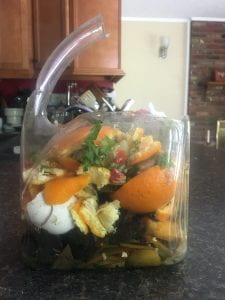
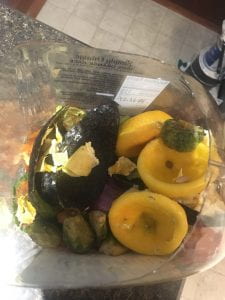
I first started my journey by collecting kitchen scraps. I cut up an empty juice bottle to start collecting. Your compost bin can say a lot about you; what mine says is that I enjoy avocados and citrus. I collected enough food scraps to fill up the container. The first day did not yield enough to start composting, so I held off until day 2.
*Pro-tip: if you do not have enough food scraps but do not want to leave them sitting on your counter overnight, you can put the container in the freezer – this prevents the scraps from rotting.
Method 1: In-ground Composting
For my first attempt, I tried to compost through a method called “in-ground” composting. This simply requires a small yard space in which you can dig a hole. According to Dirty Gardening, compost holes are the easiest composting method if you have the space and ability to dig holes.
Step 1: Dig a hole
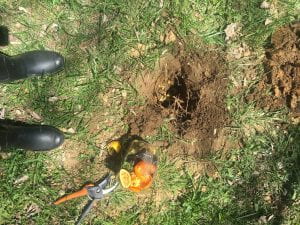
I did not have a lot of food scraps, so the hole I dug wasn’t too big.
Step 2: Cut up the big pieces of food scrap into smaller pieces so that the food can break down quicker, and to reduce the surface area.
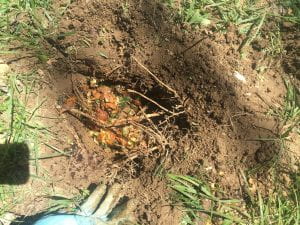
Step 3: Water it to enhance the breaking down of the food.

You only need enough water to moisten the food scraps.
Pro-tip: once watered, grab a handful of scraps and squeeze it. If a lot of water comes out, you will need to add more “brown” materials.
Step 4: Collect some “brown” materials. Mix it with your moistened food scraps.
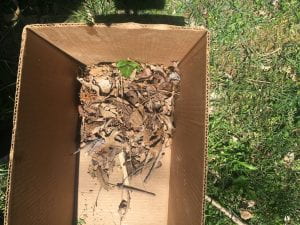
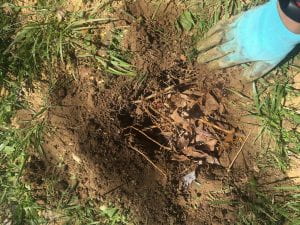
This will promote aeration in the hole and add carbon.
Step 5: Cover the hole with dirt.

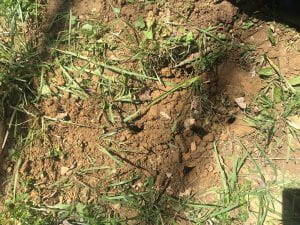
I made some holes on top of the hole using a stick so that oxygen and water can enter the hole much easier.
Step 6: Water the compost hole a few times during the week if it has not rained. Start a new hole for additional food scraps.
I conducted two trials of this method. Though in-ground composting was quite easy, I do not think it was as effective or satisfying as I had hoped. Not only could I not see the composting process happen, but I also had to wait until I had a lot of food scraps since I did not want to just dig multiple holes in my yard. As of today, I do not know if the food scraps in these holes have decomposed.
Method 2: Compost Pile in a Flower Bed
A compost pile is a standard method of composting in gardens and farms, but especially when you generate a lot of food waste. Because I have the space for it, I decided to try this out in one of my flower beds. After weeding and clearing out the flower bed, and turning the soil, I separated a corner of the plot for my composting purposes.
Step 1: Dig a small hole to create an indentation for the compost pile. Add a base layer of “brown” materials to create aeration.
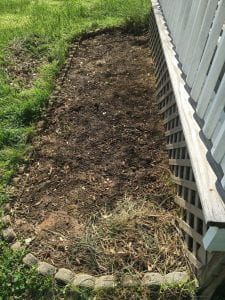
Step 2: Add cut up food scraps (a “green” layer). Water it. Mix it up with some yard waste. Water it more if needed.

Step 3: Cover it with a “brown” layer.
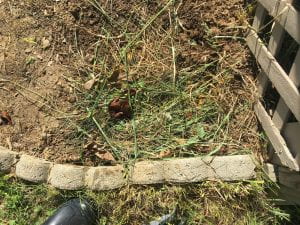
From my experience, this has helped keep everything moist and in place. It also acts as protection against animals.
I continued these steps for the next couple of days, or at least when I had enough food scraps to go and put outside. Every time I had enough food scraps, I turned the pile, watered it, and added more “brown” layers. According to the Minnesota Pollution Control Agency, turning the pile every week provides air to aid in the decomposition process and helps control odors.
For a successful compost pile, a 50/50 ratio of “brown” and “green” layers are needed.
Update #1
The pile has grown significantly! (The picture does the pile no justice.)
A closer look without the covering- it’s been drizzling/lightly raining recently, so it’s a bit mushy and wet in the plot.

I mixed up the compost with some dirt and new food scraps before adding the “brown” materials.
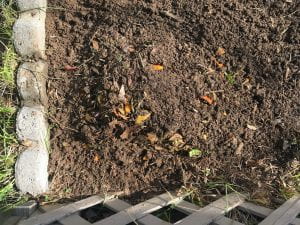
I watered it, covered it, and let it be.
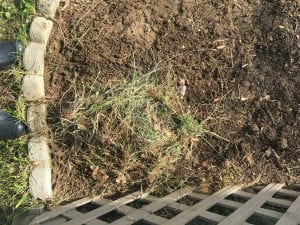
Update #2
I’ve continued the above process. Now that everyone in my household has gotten used to the food scraps container, the container gets filled up almost every day.
It’s been raining quite heavily lately, so there have been quite a lot of worms in the pile, which is great.
Today I completely removed the pile of compost out, to dig a deeper hole. I dug a hole, placed a “brown” layer in, put the compost pile back in, with the new food scraps first, and mixed up my compost.
This is the first time I was able to see some progression in the process. A lot of the orange and banana peels, which I have cut up into smaller pieces, have been getting smaller, which means they are decomposing!! My pile is now slowly turning into dirt.
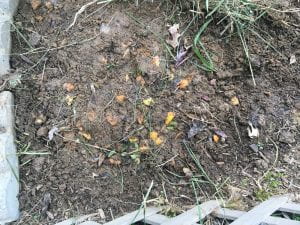
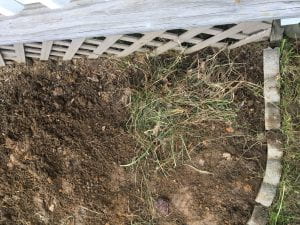
Update #3
There has been some remodeling happening on our flower bed. As seen in the picture, the flower bed is being expanded so that vegetables can be planted and harvested before summer ends.
My compost pile has also gotten quite large, and due to the expansion, it is no longer placed in an ideal spot. The compost pile may have to be transferred to a new spot where it will be unbothered, and it can grow freely.

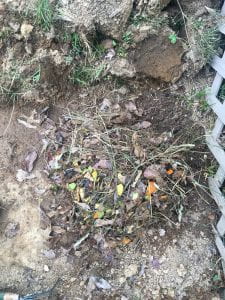
Update #4
This is my last update on the compost pile. The compost pile has been transferred to a new location; it is now behind my shed, next to a pile of yard waste I’ve created. I placed it here so it can grow freely, and for me not to worry about overcrowding the vegetables and other plants that we will be planting in the flower bed soon.
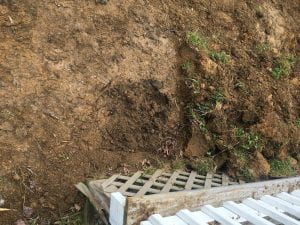

Conclusion & Reflection
Overall, this was a great learning experience for me and my family. Not only was I able to learn about the process of composting, but it also made my family take on better sustainable practices, and it allowed me to spend quality time with my sister, who helped me along the way. When I move back to SF, I hope that this composting pile does not get forgotten, but rather it becomes something that my family takes over.
I want to acknowledge that not everyone is privileged enough to have a backyard or any space to garden, but if you do, and if you enjoy spending time outside, I definitely think that you should try to make your own compost.
SOURCES
https://www.epa.gov/recycle/composting-home


